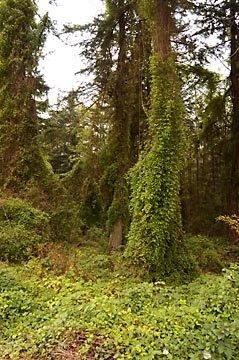By SJC Noxious Weed Control Program
While invasive weed populations are expanding at an almost exponential rate across North America, annually costing the US economy billions of dollars, we in the San Juans have been more fortunate. Weeds have been slower to establish here and relatively fewer species have become problems. Several varieties, however, have become so widespread that they offer significant threats to our forests, meadows, agricultural traditions and public health and safety.
Plants such as Scotch broom, gorse, English ivy, oldman’s beard (wild clematis) and spurge laurel will, over time, proliferate into widespread monocultures, gradually suppressing and replacing the native flora of our forests and meadows. Gorse and broom ultimately change the soil chemistry making it difficult to restore the native flora long after the invasive species have been removed. The proliferation of berries, spread primarily by birds, has caused infestations of ivy, spurge laurel and holly on San Juan County’s parks and outer islands, including wildlife refuges
Many of the invasive weeds are unpalatable or toxic to livestock, thus degrading our valuable and limited pasture and hay fields. Ingestion of tansy ragwort and the closely related common groundsel cause irreversible and cumulative liver damage and have been implicated in the deaths of horses and cattle on both San Juan and Orcas. Humans, as well, are not exempt from the toxic effects of some of our invasive weeds. Giant hogweed, a truly impressive relative of the native cow parsnip, exudes an irritating clear sun-activated sap which has caused permanently disfiguring scars on hundreds of children and adults in the Pacific Northwest over the past few years. After having ingested a tiny piece of a spurge laurel leaf, an Orcas preschooler became ill necessitating a trip to the medical clinic.
One of the greatest threats posed by noxious weeds is that of fire. It has been more than a half a century since there has been a major wildland conflagration in this county and it is no longer a question of “if” we have another major fire but rather “when.” Gorse and dry stands of Scotch broom are highly flammable, developing hot, fast moving low crown fires. While gorse is primarily a threat on Orcas, broom is wide spread, forming dense patches in both wild areas and residential settlements. Both species add to the already heavy natural forest fuel loads.
We have been fortunate in part because the San Juan Islands have remained isolated, forested, and the soil floor comparatively undisturbed. However, as our population increases, forests are being cut and soils disturbed. Invasive plants are brought in inadvertently with off-island hay, contaminated topsoil, or on purpose, as exotic ornamentals that escape into the native environment. Thus, as time passes, we are seeing more of what the rest of the nation is battling.
Controlling the spread of invasive weeds takes the eyes, ears of all of us. We can help by requesting weed-free hay and topsoil, revegetating bare land and planting non-invasive ornamental plants. For help in noxious weed identification and control, contact the Master Gardeners @378-4414 or County Noxious Weed Control Program @ 376-3499.
Thanks to Kate Yturri, Judy Winer and Gwen Stamm – Master Gardeners Graduates 2013
**If you are reading theOrcasonian for free, thank your fellow islanders. If you would like to support theOrcasonian CLICK HERE to set your modestly-priced, voluntary subscription. Otherwise, no worries; we’re happy to share with you.**









it would be nice to know how to get rid of the weeds if they are growing in your yard. I have been fighting with a clamatis that is entangled in a rhodi, that I have pulled out over and over again and it comes back every time stronger. What can I do to get rid of this plant?
Shelbi,
I would suggest emailing Judy Jackson at judy@sanjuanweeds.org. She will have some great solutions for you. You can also call her at: 376-3499.
Excellent article! Please repeat this periodically during the year.
Controlling invasive and noxious weeds (aka plant “silent killers”) are becoming one of the most pressing issues here in the San Juans, mainly because they are taking hold faster than we can eliminate them. I feel we are personally responsible to monitor our own properties and take steps to control the invasive weeds we find. For example, the Scotch Broom that is spreading so fast along the middle stretch of Crow Valley Road and up from the ferry dock along Orcas Road is on the private property side of the ditches, and therefor should be attended to by the owners of those properties. Even one plant, when it goes to seed can release thousands of seeds to be whisked along by passing cars and hungry birds.
The “Weed Board” is there for us. Judy@sanjuanweeds.org, 376-3499. They have weed wrenches to lend for Gorse and Scotch Broom, and can give eradication advice, and booklets, for all invasive species.